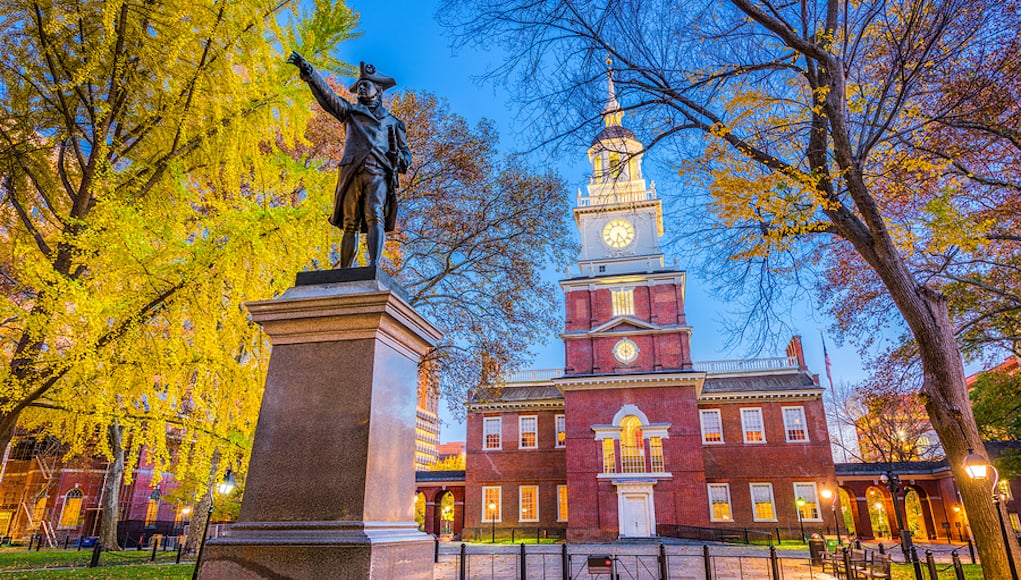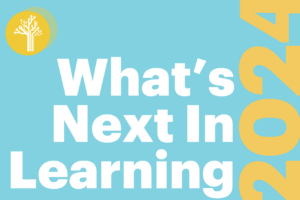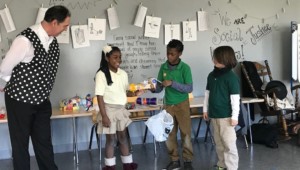Philadelphia Is Reimagining Arts & Creativity Education Programming

By Erik Day and Emily Liebtag
The School District of Philadelphia recently unveiled a new multi-phase Arts & Creativity Framework, which establishes a path forward for a comprehensive redesign and integration of arts education in the city. The Framework was developed based on 16 months of comprehensive analysis of local and national arts efforts, executive workshops with 50 local arts organizations, and conversations with key stakeholders such as students, teachers, principals, community members and civic leaders.
We’ve all heard story after story of districts and schools cutting art programs due to budgetary constraints, even though students who participate in arts and music programs are more likely to graduate high school. Philadelphia’s project is laying a foundation for change.

We believe that arts education is one of the best ways to teach kids how to learn, tap into their passions, manage projects, persist through difficulty and build their own agency. So naturally, we jumped at the chance to speak with Frank Machos, Executive Director of the Office of The Arts & Academic Enrichment for the School District of Philadelphia, Dan Berkowitz, chief strategy officer for the Neubauer Family Foundation, and Dr. Martin Ihrig, professor at Penn’s Graduate School of Education (a partner in the research that led to the Framework) and at Wharton, who have lead much of the research and planning for Philadelphia’s initiative. We were impressed with their approach.
“The groundwork research itself included talking to key beneficiaries, not making any assumptions, and trying to understand from their perspective what might be happening and what might be possible,” said Ihrig. “The beautiful thing about the project was that it was bottom up and not top down… We did it differently and really convened everyone that was important, on both the arts and education side of things and let them talk,” said Machos.

They found that students wanted more opportunities, teachers were eager for resources and relevant training, principals needed more support in scheduling and training, and partners hoped for easier ways to connect with schools.
Philadelphia then began to explore new approaches to how it could increase access and drive connectivity to quality, sequential arts education through:
- Redesigned scope and sequences for art classes and courses;
- School-based arts planning teams;
- Increased access to music and art classes for all elementary school students and multiple college and career aligned arts pathways and activities for high school students;
- Enriched learning experiences and engagement through integration of arts activities into non-arts subjects like reading, math and history; physical education; and
- Alignment of Community Arts Partners with schools and articulated needs to supplement and enrich student experiences.
As part of their work to make these plans a reality, they developed an interactive map (based on their initial research) that illustrates schools’ current arts education resources ranging from instruments to technology to teachers. “We unpacked the arts ecosystem in the city to reveal the groups that may not be as big, say, a non-profit engaging students in R&B music, and tried to see how those could be resources for the students and teachers in Philadelphia,” said Berkowitz.
The map has given them the ability “to identify the disparity in the District’s arts education resources and develop real solutions to address this critical issue.”

Not only are they being strategic about the effort, but they also are rethinking what arts education means and bringing it into the 21st century by working to incorporate the specific interests students have when it comes to arts and not solely focusing on traditional content found in music and fine arts programs.
“We have an incredible opportunity to redefine arts education to be more reflective of the diversity of our students and city, building on an already strong foundation and legacy of arts programs in our schools while increasing accessibility and engagement. This Framework provides a pathway and structure to better align efforts, articulate roles, provide support and ultimately serve the greatest needs of our students and teachers,” said Machos.
They could even, said Dr. Ihrig, “do the same thing for the sciences, and map out the big companies that have labs and other players in the city, and figure out how they can leverage their resources for science education.”
What we think is so cool about Philadelphia’s program is that it is developing a model for circumventing (or at least alleviating) the budget constraints that so many districts and schools face with their art programs. By involving all stakeholders from the start, sharing out the knowledge they found about existing resources and potential partnerships, and setting a strategy for better connecting those resources to the various areas of their education system, they’ve developed a straightforward path for making community and district resource allocation vastly more efficient.
Supported by the Neubauer Family Foundation in partnership with The Philadelphia Orchestra and the University of Pennsylvania, we are excited to see what’s next for Philadelphia’s Arts and Creativity Framework.
For more, see:
- Arts Integration for the Future of STEAM Learning
- 5 Tech-Free Classroom Innovations, and Ideas for Getting Started
- Why Communication is Critical for Personalized Learning Success
Stay in-the-know with all things EdTech and innovations in learning by signing up to receive the weekly Smart Update.






0 Comments
Leave a Comment
Your email address will not be published. All fields are required.